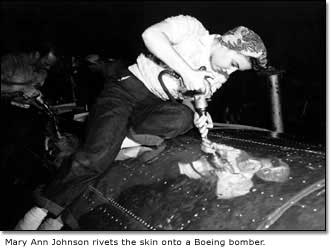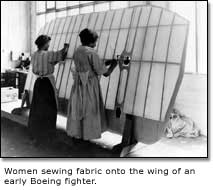|
||||||||
| Historical Perspective |
| 'Rosie' a pioneer for women BY MIKE LOMBARDI  History
shows that women played key roles at Boeing, and that the name Rosie goes
way back before World War II. History
shows that women played key roles at Boeing, and that the name Rosie goes
way back before World War II.Shortly before the company was incorporated in 1916, William Boeing hired the company's first female employee, Rosie Farrar, to sew the fabric on the company's first airplanethe B&W. By 1918, Boeing had an entire department of highly skilled women seamstresses who, along with other female employees, made up almost 25 percent of the early company's work force. One of those women, Helen Holcombe, was a pioneer for female engineers when she joined the Boeing Drafting Department in 1917. These early employees helped ensure the success of the company in its infancy and proudly contributed to the war effort during World War I, just as their daughters and granddaughters would in a later war. One of the heroes of World War II was "Rosie the Riveter," a name proudly adopted by the millions of women who, driven by a patriotic spirit for the war effort, took up jobs at shipyards, armament factories and aircraft companies to help build the "arsenal of democracy." The identity of the original Rosie (if there ever was one) is uncertain and may be lost in history. Possibly the earliest inspiration for the name was a 1942 song, "Rosie the Riveter," written by Redd Evans and John Jacob Loeb. Later, the cover of the May 29, 1943, Saturday Evening Post featured a Norman Rockwell painting of "Rosie," which introduced the image of a confident workingwoman holding a rivet gun. Rosie the Riveter not only made a great impact on the nation, but on Boeing as well. In 1942, about 15 percent of employees were women and by 1944 that figure rose to more than 40 percent. In 1943, as the war escalated, Boeing employment faced a crisis. As increasing numbers of male employees were summoned to war, schedules were falling behind due to the shortage of skilled employees.  Boeing
turned with great hope to a promising pool of untapped female talent, but
it would not be easy, as many women didn't want to leave behind more traditional
roles to enter the workforce. Boeing
turned with great hope to a promising pool of untapped female talent, but
it would not be easy, as many women didn't want to leave behind more traditional
roles to enter the workforce. However, the serious situation of war brought people together in many ways to address their concerns. The government and the media assisted the aviation industry by addressing some major issues. Boeing created a transportation department that organized ride sharing and busing. The company assisted working moms in locating daycare and provided work shifts that would allow mothers to be at home during the day. Boeing also added more breaks and more access to nutritional meals by building a new cafeteria. An extensive recreation program was put into place that helped all employees cope with the stress of work and the war. The media encouraged women to understand that going to work in the factories was socially acceptable and would not jeopardize their roles at home. Life magazine even declared female war workers "The Glamour Girls of 1942." Another hurdle was appropriate dress for manufacturing work. Safety and appearance were top issues, and many companies introduced stylish uniforms that were functionally designed for work in the factories. Boeing, for example, worked with a major department store in Seattle to develop working fashions. In time, major hurdles were cleared and The Boeing Company was very successful in employing more Rosies. A testimony to the success of the effort was the fact that most Rosies chose to stay after the war and continued opening many new frontiers for women. michael.j.lombardi@boeing.com |
| Contact Us | Site Map| Site Terms | Privacy | Copyright | ||||||
| © 2002 The Boeing Company. All rights reserved. |